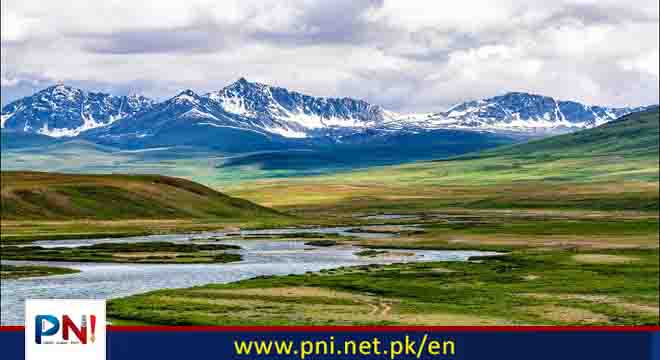GILGIT BALTISTAN, Sep 17 (APP):Amidst tall peaks and lush green valleys, lies down the Deosai plain, yet another jewel in the crown of Gilgit-Baltistan, adding to the memorable beauty of Northern Areas.
Also known as the Deosai National Park, it is a high-altitude plateau situated in Gilgit Baltistan region of Pakistan within the western Himalayan range, not far from the Central Karakoram Range and east of the mighty Nanga Parbat Peak.
Embracing exceptional beauty and ecological value, the plateau is situated at an altitude of 3500 to 5200 meters with an area of 358,400 hectare of flat but undulating plains broken by gently rolling hills and surrounded on all sides by mountains. It forms a stark contrast to much of the adjacent landscape made up of narrow valleys between steep mountains.
Surrounded by the valleys of Skardu, Kharmang, Astore and Gultari, this beautiful place is administratively divided between Skardu, Astore and Kharmang districts of Gilgit Baltistan.
The name “Deosai” itself tells a fascinating story. It’s a combination of “Deo” (meaning giant) and “Sai” (meaning shadow). This moniker reflects the fear people had in the past of venturing into the unknown, often attributing the mysterious to the supernatural. Deosai, therefore, translates to “the shadow of a giant,” earning it the nickname “the land of the Giants.”
Another fitting name for this plateau is the “Roof of the Earth,” as it stands as the world’s second-highest plateau, towering at approximately 4,114 meters (13,497 ft) above sea level.
For much of the year, lasting around eight months, Deosai is blanketed in snow. However, the remaining months grace the plateau with pleasant weather, showcasing a vibrant array of flowers in a multitude of colors.
Deosai is dotted with several lakes, including the stunning Sheosar Lake, located at an elevation of around 4,142 meters (13,589 ft) and widely known for its crystal-clear waters and picturesque surroundings. It is home to fresh trout, providing sustenance for bears and locals alike. Imagine standing amidst this breathtaking landscape, with towering peaks in the background and clouds so close that you could easily touch them.
“I was always passionate about nature and adventure. By visiting Deosai another dream of my life comes true. Its memories would continue to spark in my mind for years,” said Sarah who all the way came from Karachi to see the natural beauty of Deosai plain.
“The moment I set foot on the plateau, I was awestruck by the sheer vastness of the landscape. It was like being on top of the world,” she said depicting the beauty. “The summer wildflowers painted the plateau in a riot of colors and the clarity of Sheosar Lake was unbelievable. It is a paradise for nature enthusiasts.”
Beyond its natural beauty, Deosai holds great watershed value as it is the source of three vital river systems – Kala Pani, Bara Pani and Shatung Nala – that join together to form the Shigar River, a significant tributary of the mighty Indus River.
Being a sanctuary for variety of unique wildlife species, the Pakistan Government declared it as Deosai National Park in 1993, primarily to protect the Himalayan Brown Bear. Otherwise, it is also a home to Himalayan wildlife like Himalayan Ibex, Snow Cock, Snow Leopard, Ladakh Urial, Kashmir Musk Deer, Himalayan Wolf, Himalayan Marmot, vultures and a diverse range of over 124 resident and migratory bird species.
It is a birdwatcher’s paradise, boasting Bird Life International’s Western Himalaya Endemic Bird Area and serving as a resting spot for countless avian travelers.
“The park offers a rare opportunity to connect with wildlife in a pristine setting,” remarked Farman Karim, a known wildlife photographer. “The chance to capture the elusive Himalayan Brown Bear and other unique species in their natural habitat is unparalleled.”
Farman who used to spend lot of time for a real image capturing of the rare species explains, “I spent weeks here, observing their behavior and waiting for the perfect shot. It was itself a unique experience that left indelible imprints on my mind.”
Deosai is accessible from June to September as in winter it receives heavy snowfall. From Skardu city, it takes one to two hour to Deosai National Park via Sadpara. Visitors can travel via Car, Jeep and other vehicles but mostly jeeps and four-wheelers are recommended for travelling. It is also accessible via Chilim, Astore Valley. After a long journey from Islamabad to Astore, one can reach Chilim Valley on way to Sheosar Lake.
“I have seen visitors coming here from all over the world and mesmerizing by grandeur and unmatched beauty of Deosai plain,” remarked Ayesha, a local guide. “Deosai is not just a place; it is an experience and I take pride in showing them the wonders of Deosai.”
Conscious of protection of the ecosystem, Ayesha says, “while I brief them about incredible landscapes and unique flora and fauna of Deosai, I always encourage them to respect and preserve this delicate ecosystem.”
Just to say, Deosai plateau is gem of Pakistan’s tourism landscape, a place of unparalleled beauty and ecological significance. The Land of Giant is always there to sway the nature and adventure loving people with its enchanting beauty.








